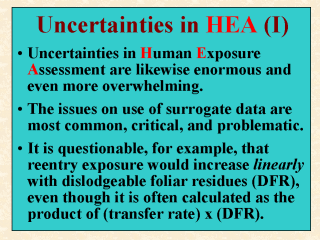| front |1 |2 |3 |4 |5 |6 |7 |8 |9 |10 |11 |12 |13 |14 |15 |16 |17 |18 |19 |20 |21 |22 |23 |24 |25 |26 |27 |review |
 |
The
uncertainties associated with human exposure assessment (HEA) are likewise enormous and
even more overwhelming. HEA is often thought to be more dynamic and complex than toxicity
assessment (TA). This is because the overall framework for TA is more solid compared to
that for HEA. And toxicity studies generally are better designed than human exposure
studies. Of all the uncertainties associated with HEA, perhaps the issues on the use of surrogate data are most critical and common. For example, as pointed out in Lecture 8, reentry exposure for harvesters is often estimated by multiplying a dermal transfer rate (TR) by the dislodgeable foliar residues (DFR). The TR is functionally similar to a cancer potency factor, or to the slope of a dose-response curve for noncarcinogenic effects. It is a ratio (or rate) as well as a summary of past reentry experience later reused to relate dermal exposure (i.e., dermal residues) to foliar concentration. That is, this estimation algorithm asserts that reentry exposure increases linearly with DFR. There are at least 3 limitations with the above assertion. First, only a certain range of DFR is likely to have an impact on reentry exposure. Second, there has not been sufficient evidence supporting the assertion that doubling the DFR would double dermal residues. Third, TR learned from studies for one chemical or one class of chemicals may not be appropriate for another, even when the reentry tasks involved are similar. After all, the transferability and dislodgeability of foliar residues may also depend on the temperature and the pH of the foliar residues, including even the worker's sweat. |